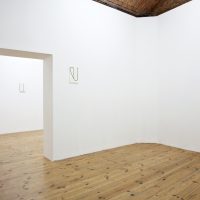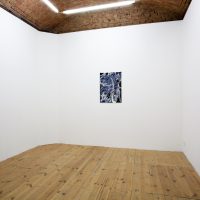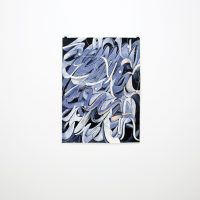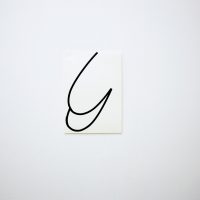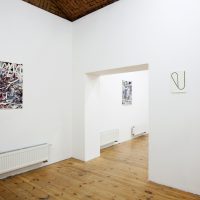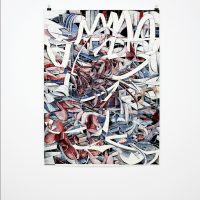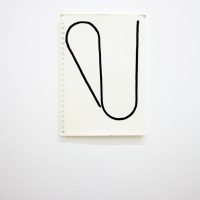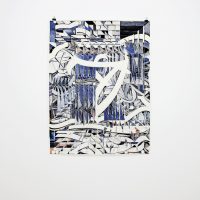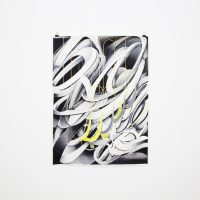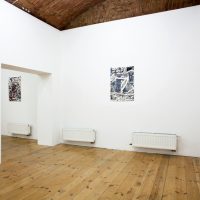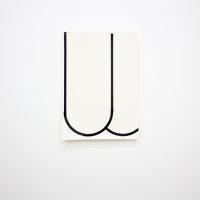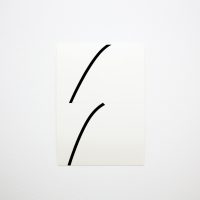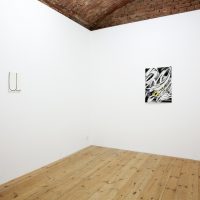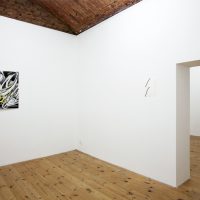11/1/2019 – 8/2/2019
One recent morning, as I stepped out of my building in our run-down housing estate, I found an old birds’ nest that had fallen from a tree onto the ground. Although I’m usually a bit groggy in the morning, somehow my eyes automatically and almost immediately focused on it, on its regular, “intelligent” structure, which felt out of place, too organized – synthetic, even – amidst the surrounding chaotic undergrowth. It seemed to possess intent, thought, strategy… At least, I couldn’t think of another reason why it stood out as it did from its surroundings. In my view, the same goes for the abstract compositions of Tomáš Bárta – here, too, color is not the primary thing.
I peer into the glass display case of a local haberdashery. The main thing is to show things in an attractive arrangement. That works. Buttons, ribbons, spools, brooches, beads. Silver and golden glitter. I really need the golden ones, which can be sewn together into a kind of flexible snake. What does it do? It has a skeleton, but it can be moved. It’s fun for a little while, but then again it’s not all that big a thing, either. One single thing from this beautifully overflowing case is simply not enough… Taken alone, it does not suffice, and yet it is also provocative. Focused mind and energy flow from the whole to the individual object and back again. A thing can and cannot be alone. The line both determines the painting and is determined by it. The whole and its part, the structure and a single element – one results from the other but at the same time it all exists at once. Can this relationship be untangled, and is there even any point?
On another day, I am looking out the window, watching the local crazy guy as he walks back and forth, cigarette in hand, through the entire geometric tangle of pedestrian paths in our housing estate. He does so with absolutely seriousness and concentration, as if the entire universe would otherwise collapse into chaos and eternal ruin. I wonder whether madness is related to the absence of structure, the inability to stick to established models of behavior that society considers functional and acceptable, or whether it is the result of a state in which these models proliferate before our eyes to such an extent that they prevent us from seeing anything else. Bárta’s compositions are also full of structures. In fact, they overflow with them. They disintegrate, repeat, and are layered one over the other, or they compete with one another. But they are not a direct, intuitive reference regarding the form or structure of our thinking; instead, they are a conglomerate of diverse visual sensations and influences that reflect Bárta’s interest in the world of art, design, and architecture – for they possess a certain nostalgic undertone, reflect his personal experience with the world of art, and also show his ambition to find his own unique and inimitable artistic vocabulary.
Painting somewhere between holding together and falling apart. There are bones, but the skeleton is no longer visible. The flesh has lost its original form and lies, arranged on the counter, in a strange in-between state before becoming something that will again make sense. Chopping it into its constituent elements is the only path towards creating a complete picture; otherwise, it would all be for naught.
When an underage gymnast waves a ribbon high above her head, I always feel a light sense of giddiness and affection, as if that fleeting moment, those abstract symbols she creates in space that always dissolve just before we can read their mysterious message, contained too much: the fragile, temporary, and random nature of our very existence. In Bárta’s large-scale color paintings, the lightness of rhythmic gymnastics has partially engulfed his strategic considerations and tendencies towards perfectionism. It is a little like seeing the gymnast’s entire routine in one single frame of film.
Motivic saturation results from the repetition of the motif (a figure, a fragment), through changes in interval, length, and rhythm, through its ornamentation or inversion, by turning it around, or through its multiple exposure. Why not remove several motifs (the ribbon, pearls, buttons) as a form of control and comparison? Because God only knows what would happen then…
curated by Pavel Švec & Jaromír Novotný
